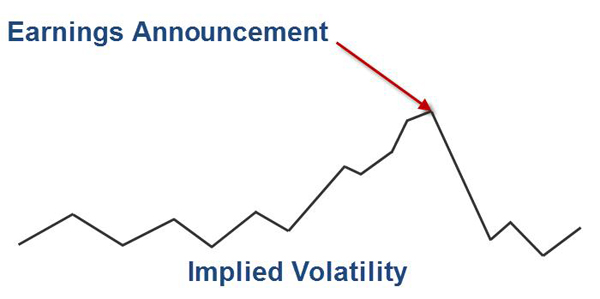
The reason is simple: over time the options tend to overprice the potential move. Those options experience huge volatility drop the day after the earnings are announced. In many cases, this drop erases most of the gains, even if the stock had a substantial move. In order to profit from the trade when you hold through earnings, you need the stock not only to move, but to move more than the options "predicted". If they don't, the IV collapse will cause significant losses.

Kirk Du Plessis from OptionAlpha seems to agree.
He conducted a backtest proving that holding a straddle through earnings is on average a losing proposition.
Here are the highlights of his research.
Key Points:
- Often times traders go through cycles where the stock makes incredibly big moves.
- This encourages traders to buy long straddles heading into earnings; a long call/put at the money assuming that the stock will make a big move so that you can profit from it.
- However, it is not the case that the stock always consistently moves more than expected in the long term. The market is smart enough to overcorrect and implied volatility always overshoots the expected move, on average.
Case Study 1: Apple
Did a long straddle every time earnings were present, all the way back to 2007 through now. This is a lot of earnings cycles and a lot of different information for Apple. Since then Apple has had a considerable move, which really challenges the validity of the strategies. We entered a long straddle at the money the day before earnings and took it off the next day. The stock was trading at $90; we bought the 90 put and the 90 call and closed it right after earnings were announced the next morning.
Results:
- A long straddle in Apple for earnings only ended up winning 41.38% of the time.
- The average return over 10 years was -1.31%.
- Over the long haul, a long option strategy results in a negative expected return, especially in a stock like Apple.
- On the opposite end of this trade, if you had done the short straddle instead of buying options, you would have generated at least 60% of the time and expected a positive return.
- The straddle price before earnings, on average, was $15.
- The straddle price directly after earnings went down to about $7.95; not a great choice for long-option buyers.
Case Study 2: Facebook
Entered the same long straddle position, entering right before earnings were announced and exiting again right after earnings were announced. This strategy only won 27% of the time, which is a huge miss for Facebook percentage-wise. These long options strategy simply do not perform as well as we think over time.
Results:
- Had an annual return of 0.70%.
- Only a couple of months ended up being the determining factor to keep it above board.
- If you missed a couple of those really big moves or if Facebook moved much higher than expected, then it would have resulted in a much more negative return.
- On the counter side, if you had traded the short option strategy it would have worked out well, generating a positive expected return.
- On average, the market priced these straddles at about $5.62 before earnings.
- After they announced earnings, the straddle pricing went down to $1.78.
- The key was that the crash in the volatility and the straddle pricing is really why this strategy was a big loser.
- However, this was a really good winner for option sellers.
- The average expected move in Facebook was $6.45 and the actual expected move on Facebook was $7.09.
- Facebook out-performed on average.
- If you could remove the biggest outlier from 2013, then Facebook under-performs by $6.16.
- More recently, Facebook has begun to consistently under-perform its expected moves.
Case Study 3: Chipotle
With Chipotle we used the same strategy as with Apple and Facebook, entering into a long straddle right before earnings and exiting it right after earnings.
Results:
- The overall win rate was 35.48%.
- The average annual return was -2.59%, losing a significant amount of money in the trade.
- This again consistently led option sellers to be the beneficiaries of the earnings trade in Chipotle.
- The average price of the straddle heading into the earnings event was 26.26%.
- The stock went from the low 60's, all the way up to the 600's and back down to 400 - so the straddles are naturally going to be more pricey.
- On average the straddle price was 26.26 and after earnings the straddle price was 11.21, collapsing by more than half.
- There are huge moves in Chipotle, but they do not overshadow what actually happened in the long term.
- Expected move in Chipotle was 7.01 and the actual move was 5.28 - the market vastly underperformed.
Conclusion:
- After big moves, we start to see expected moves and the stock expands and then smaller moves follow.
- Generally speaking, when the stock outperforms the expectation the next couple of cycles end up being fairly quiet.
- If we do find ourselves in a quiet period where the stock has performed really well, we should be careful that it could surprise us shortly.
- Likewise, if the stock has been really volatile and has outperformed and moved more than expected in the last couple of cycles that means we could potentially be more aggressive as it might underperform heading forward.
- Generally, there is also a lag time between the market catching up - earnings trades only happen four times a year.
- The market participants don't get a lot of data throughout the year to make changes to expectations and trading habits.
- If the stock has a huge move after earnings, more than expected, it might take a cycle or two for the options pricing to catch up and realize the new normal.
- At the end of the day, realizing how much these numbers gravitate towards what they should be on average, long-term is really powerful.
You can listen to the full podcast here.
This research confirms what we already knew:
It is easy to get excited after a few trades like NFLX, GMCR or AMZN that moved a lot in some cycles. However, chances are this is not going to happen every cycle. There is no reliable way to predict those events. The big question is the long term expectancy of the strategy. It is very important to understand that for the strategy to make money it is not enough for the stock to move. It has to move more than the markets expect. In some cases, even a 15-20% move might not be enough to generate a profit.
Thank you Kirk!
The next question is of course: if holding a long straddle through earnings is a losing proposition, why not to take the other side and short those straddles?
But lets leave something for the next article..
Related articles:
- How We Trade Straddle Option Strategy
- Buying Premium Prior To Earnings - Does It Work?
- Can We Profit From Volatility Expansion Into Earnings?
- Long Straddle: A Guaranteed Win?
- Why We Sell Our Straddles Before Earnings
- Selling Strangles Prior To Earnings
- Straddle Option Overview



There are no comments to display.
Join the conversation
You can post now and register later. If you have an account, sign in now to post with your account.
Note: Your post will require moderator approval before it will be visible.